Download our Coronavirus China Economic Impact report
The Coronavirus China Economic Impact report covers the spread of the outbreak in China, what industries are growing, and which industries are severely impacted. We also zoom in on the economies of Wuhan and Hubei, as well as Coronavirus impacts on the global supply chain. Lastly, we share how the Chinese government is reducing the burden on enterprises. Our Coronavirus China Economic Impact report is available for free to anyone seeking to understand the COVID-19 outbreak’s effect on businesses in China.
This report is routinely updated and contains everything businesses need to know about the economic impact of the Coronavirus in China. It is a collection of research from many respected firms and organizations combined with our own careful analysis.
Overview of COVID-19 spread in China
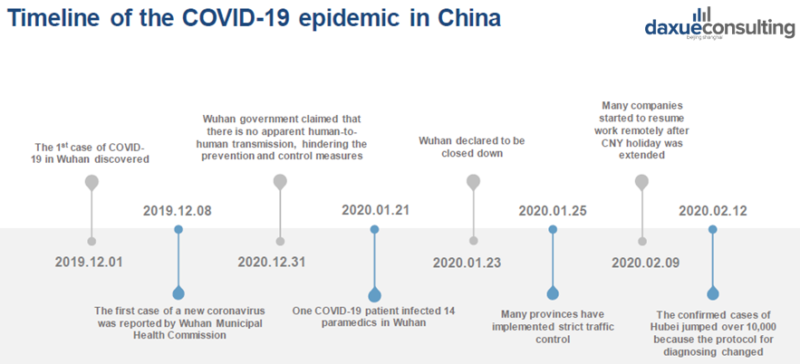
[Source: Coronavirus China Economic Impact report by daxue consulting, the timeline of the COVID-19 outbreak in China, from December ’19 to February ’20.]
Coronaviruses are common causes of respiratory infections. They have previously been implicated in viral outbreaks, including SARS-CoV and MERS-CoV, but are also responsible for some common colds. From the perspective of virus evolution, COVID-2019 is more advanced type than its two predecessors. It has never been found in humans before.
How COVID-19 starting during the Lunar new year affected spread
The 2020 Spring Festival migration started on January 10 and ended on February 18. The estimated number of people who have had contact with confirmed cases gradually increased at beginning of the Lunar new year and stabilized until the end of it. That’s because flow of people participating in the Spring Festival Transport is very large, which makes the chance of cross infection increase and directly lead to the peak of the epidemic. Government restrictions on the flow of people helped to reduce the spread of the virus by decreasing contact and increasing physical distance between those who have COVID-19 and those who do not. However, within China, the confirmed cases have flattened since February 13.
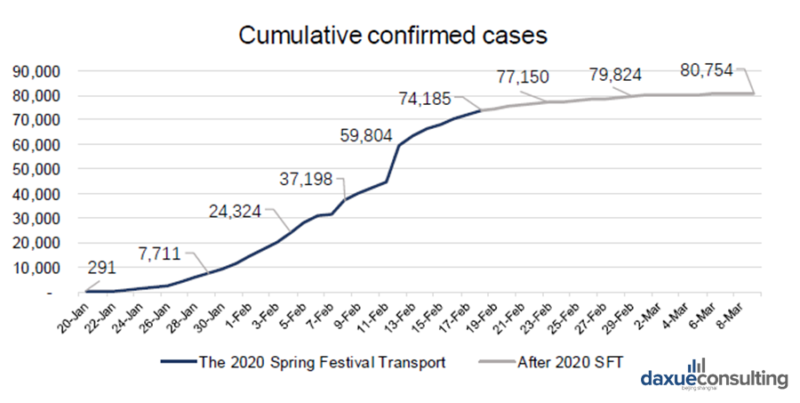
[Data Source: National Health Commission of the People’s Republic of China, Coronavirus China Economic Impact report, daxue consulting. The number of new cases in China has flattened out in mid-February.]
How long will the coronavirus last in China?
As of early March, the number of infections in China continues to decline, with the exception of Hubei, the infection in all regions seems to be controlled. As long as no new infections appear during the duration of a full incubation period, then the epidemic can be considered to be officially over. Currently, the rate of infection is minimized by the quarantine efforts and shutting down of workplaces and public places.

[Data Source: China84000.com, Coronavirus China Economic Impact report by daxue consulting, expected end of epidemic by province.]
What is the Coronavirus economic impact in China
Do we need to worry about the impact of coronavirus on GDP?
According to chief economist from Zhongtai Securities and Donghyun Park from Asian Development Bank, the coronavirus economic impact in China is expected to be between 1.5% and 2% in terms of GDP growth, which will not change the long-term trend of China’s economy. The epidemic has a large impact on the economic growth rate in the first quarter, or negatively affects the GDP growth rate of about 2%-3%. However, as the virus continues to spread globally, there will be many more factors to include in the coronavirus economic impact on China including global demand of Chinese goods and commodities. The largest economic impact comes from the service sector, especially the catering, transportation, hotel, tourism, and accommodation industries.
Up close on the economies of Wuhan & Hubei
The huge outbreak in Hubei province contributed a lot to coronavirus economic impact in China, as it is the most developed province in the central region of China with 3.9 trillion RMB GDP in 2018. Hubei has a large number of industrial clusters in R&D and manufacturing, such as automobile and electronics.
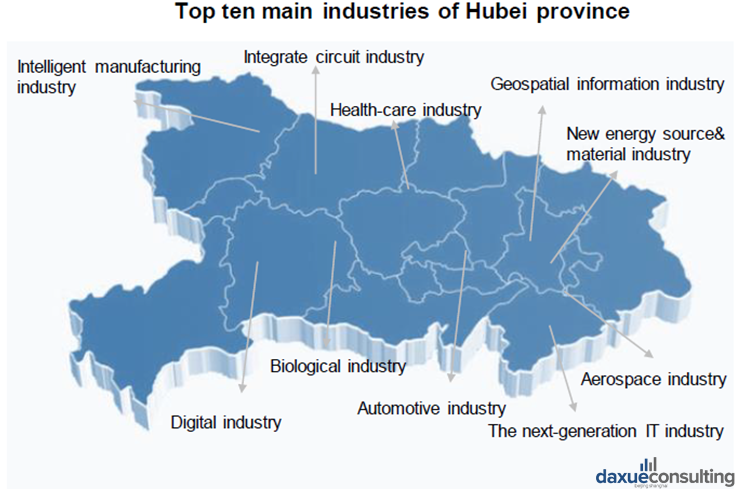
[Source: Finance.EastMoney.com, Coronavirus China Economic Impact report by daxue consulting, the top ten industries of Hubei province]
According to government work report of Wuhan in 2019, electronic information, bio-technology and new medical and medical appliance, and the automobile industry are the three pillars of the manufacturing industry.
Hubei province is an important part of the global supply chain. It accounts for 9% of total Chinese auto production. German engineering firm Bosch, the world’s largest auto component manufacturer, has dozens of factories in China 2 of them are in Wuhan. Hubei also plays a significant role in the global supply chain of critical electronics components. The province is the production base of Taiwan’s PCB factories, including Taiwan Optoelectronics, Xinxing, Jianding, Nanzi Electric, and Dingying. Industry insiders pointed out that PCB is the “mother of the electronics industry” and is an indispensable key component of all electronic products. If the PCB factory in Taiwan and the Hubei factory are obstructed, it will affect the global electronics industry.
Hubei contributes much to the progress of the chemical industry. It is the largest province of chemical fertilizer in China, its output has reached to 596.56 tons in the first three quarters of 2019, which increased 19% compared to last year. Hubei has a high production capacity of sub industries including the phosphorus chemical industry, pesticide industry, and the vitamin industry.
COVID-19 affects industries in Hubei
Coronavirus impact on supply chain in China can be also seen in some industries in Hubei.
Electronics industry
After Wuhan postponed production of electronics, China’s supply chain of critical electronics components is facing a catastrophic disruption. About 70% of the world’s smartphones has been affected. According to Strategy Analytics, overall shipments of phones will reduce by 2% in 2020, some consultants believe that COVID-19 will cause demand side decrease. Besides, the first quarter is normally off-season of China‘s semiconductor industry, COVID-19 may further dampen the sales of semiconductors.
Automotive industry
China auto sales fell 2.8% in 2019 amidst global trade tensions, the first decline in nearly two decades, which also affect Hubei auto sales because Hubei province account for 9% of total Chinese auto production. Global automakers forecasted further sales decline in 2020, prior to knowledge of the coronavirus outbreak.
COVID-19 China economic impact: online industry growing

[Source: Qimai, China Coronavirus Economic Impact report by daxue consulting, online activity during the Coronavirus outbreak]
Due to the coronavirus epidemic, Chinese daily life goes online. For example, gaming industry experienced an unprecedented growth. While the Chinese mobile gaming industry is stimulated by the coronavirus, the development of 5G is expected to accentuate the trend and support the growth of the industry.
Coronavirus economic impact in China is also observed in short video platforms sphere. Between January 20 and February 2, 574 accounts on the short video platforms Douyin and Kuaishou each gained between 100k-500k new followers. The Coronavirus is accelerating the shift towards live-streaming, which already exploded in 2018, with a 745% growth year on year, thanks to improved connectivity and video maturity. The short video sector recorded 569 million daily active users in the post-holiday period, far exceeding 492 million on a regular daily basis.
E-commerce purchases during the Coronavirus outbreak in China
During the Chinese New Year in 2020, people were likely to purchase medical products, hygiene products and food online. To support the new growing online demand, more than 35,000 jobs were created across China from the following online retailers: Hema, Suning Xiaodian, Meicai, JD Logistics, JD daojia, and Dada.

[Source: Fanli.com, JDbigdata, cnn, App Annie, e-commerce sales of necessities rose during the Coronavirus outbreak in China]
Studying and working go online during coronavirus outbreak
Most companies have set-up remote work policies to avoid contamination at work. Hence, Enterprise Collaboration Apps facilitated remote working for 200 million Chinese workers after the Chinese New Year. To keep in touch, they use apps produced by two China’s online-giants: Alibaba and Tencent. During the outbreak, Alibaba’s Ding Talk skyrocketed to the very top of the App Store in a few days while Tencent Meeting and WeChat Work are in the second and fifth position, respectively.
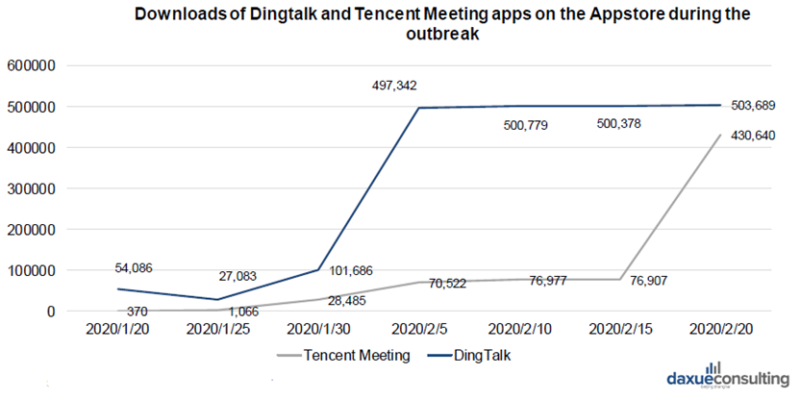
[Data Source: Forward-The Economist,App Annie, Qimai, Coronavirus China Economic Impact report by daxue consulting, downloads of Dingtalk and Tencent Meeting apps rise.]
The Coronavirus outbreak does not stop Chinese students from studying. Universities across the country organize online lectures to ensure the safety of their students. They rely on QQ, a Tencent streaming platform to carry out online teaching. The downloads of some education apps such as Tencent Classroom, and China University Mooc experience a significant increase. However, unlike fitness and co-working apps, the online education peak during the coronavirus may not last after the epidemic, with the return of students back to school.
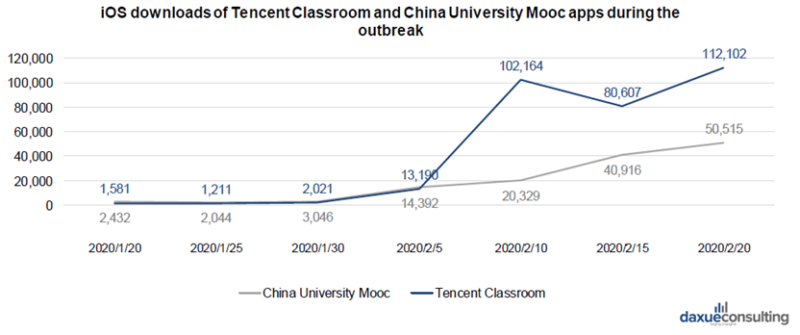
[Data Source: Qimai, Coronavirus China Economic Impact report by daxue consulting, students continue studies online during Coronavirus outbreak]
Coronavirus impact on tourism in China
The damage to the Chinese tourism industry because of outbreak is equivalent to a loss of 1 trillion RMB GDP. Many travel enterprises estimated the ongoing shutdown costs the industry about ¥17.8 billion every day.
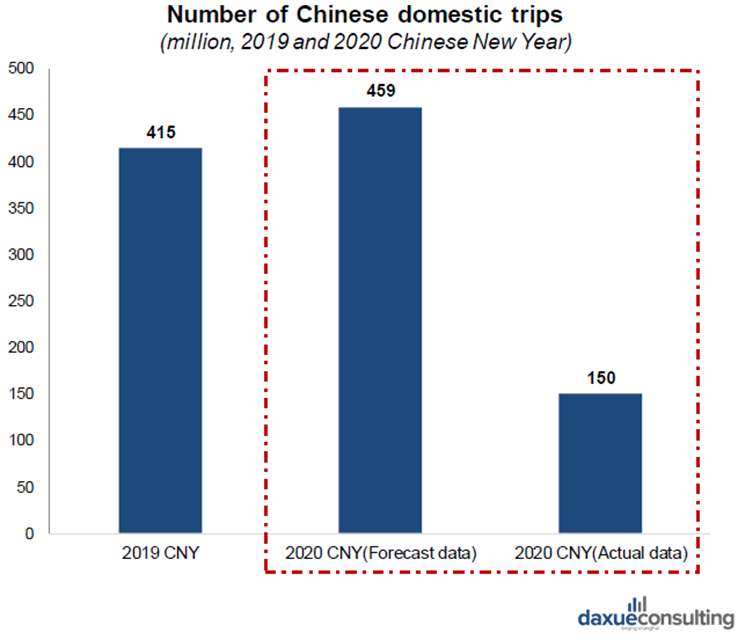
[Data Source: Tai Media APP, Sina Finance, Coronavirus China Economic Impact report by daxue consulting, the actual number of domestic trips during CNY 2020 is less than one third of the forecasted amount.]
Only 2% Chinese tourism related companies felt that they had not been significantly affected after the COVID-19 outbreak. Coronavirus impact on tourism in China especially visible among travel agents, hotels, and retailers (related to tourism), as they badly need sales revenue during the epidemic.
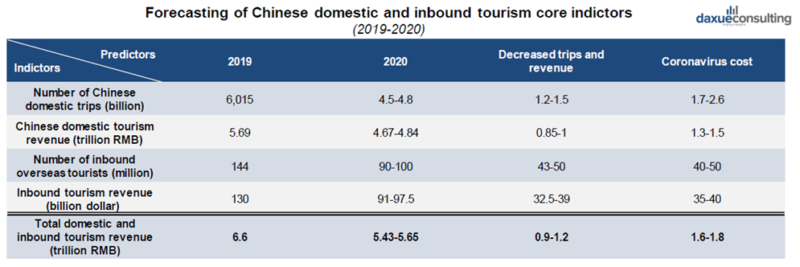
[Data Source: Sohu Finance, Coronavirus China Economic Impact report by daxue consulting]
Chinese tourists contribute to the tourism industry in many countries. For instance, in 2018, Chinese tourists represent more than 70% total tourism in Hong Kong and Macao, similarly, more than 25% total tourism in Thailand, Japan, Vietnam and Korea. The impact on the economies of these countries will be catastrophic, if the coronavirus outbreak lasts for three to six months.
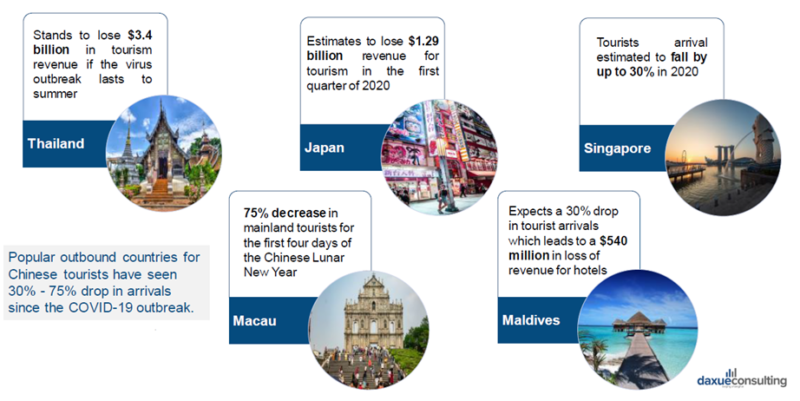
[Source: Press reports; McKinsey Global Institute; Pengpai News, Coronavirus China Economic Impact report by daxue consulting]
Coronavirus impact on tourism in China opened the opportunities for new online approach in this sphere. During the COVID-19 outbreak, many scenic areas and museums used live-stream to increase exposure and attract tourists, which attracted a lot of traffic. Even after the outbreak, the live-stream still can be watched by elderly and people with disabilities, it also can be used as a preview before travel.
Short-term and long-term coronavirus impact on tourism in China
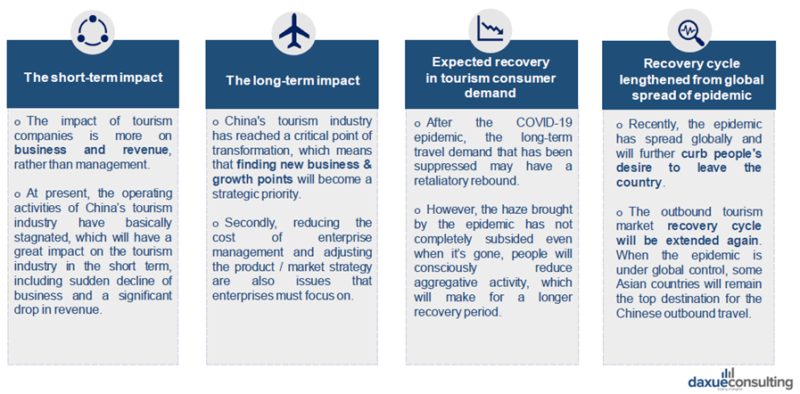
[Source: TravelDaily, Coronavirus China Economic Impact report by daxue consulting]
Coronavirus impact on the food and beverages industry
Although many restaurants in China strengthened their delivery safety during the outbreak in China, food delivery alone is not enough to keep their profits in the positive. The Chinese New Year is usually a hot season for the F&B industry, the total revenue of Chinese restaurants in 2019 CNY has reached 724.1 billion RMB (occupied 15.5% of the whole revenue in 2019). Because of the Coronavirus outbreak, large catering brands have to reduce expense to balance their finance, such as permanently shut down some offline stores and redundancies. Many small restaurants are facing with the risk of bankrupt, since they have very fragile anti-risk capability. Many Chinese restaurants (around 62%) could not get rent reduction and they still need purchase epidemic prevention products, such as protective facemasks and thermometers.
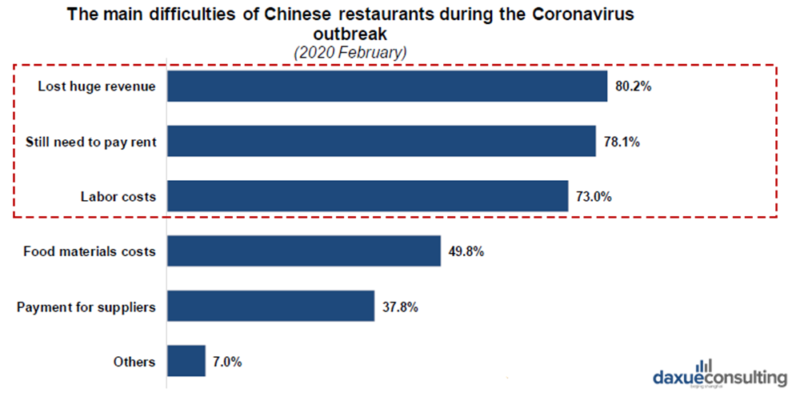
[Data Source: World Federation of Chinese Catering Industry, Coronavirus China Economic Impact report by daxue consulting]
Currently, many restaurants try to focus on delivery to get some profits, but actually revenue of online food delivery business is much less their normal business.
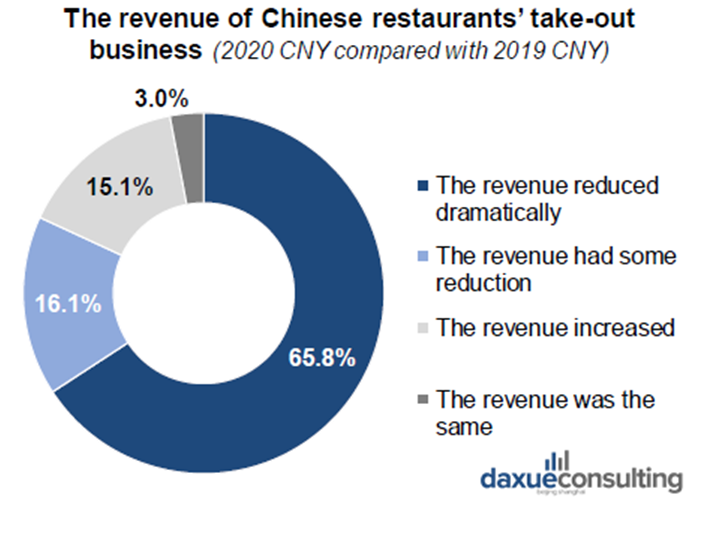
[Data source: World Federation of Chinese Catering Industry, Coronavirus China Economic Impact report by daxue consulting]
In order to manage the losses, some restaurants sell food materials to consumers and communities at low price and provide free food to medical staff and government units in epidemic areas. From 1st February 2020, many restaurants temporarily lend employees to Hema (盒马鲜生) which relieved their labor costs. At the same time, KFC launched a contactless delivery service on food ordering platforms, such as Meituan (美团). Because of a lack of funds, some restaurants tried to seek investments and loans. For instance, Pudong bank offered 120 million RMB loans to Xibei (西贝) restaurant. The large food ordering platform Meituan (美团) worked with banks to finance some restaurants.
Coronavirus impact on supply chain in China: what businesses can expect
How Coronavirus will impact the Global Supply Chain by Mid-March
Most Chinese manufacturing slowly started resuming operations at the end of February, but the delays could have a devastating impact on the global supply chain. For most companies, the inventory in stock will is enough to keep up with demand for two to five weeks. Shipping by sea to either the U.S. or Europe can take around 30 days. This implies that if Chinese plants stopped manufacturing prior to the beginning of the Chinese holiday on January 25, the last of their shipments arrived the last week of February. If lead time from China is shorter than 30 days, the disruption occurs earlier. This is already the case with Hyundai which announced on February 14th the suspension of its production lines from its plants in Korea.
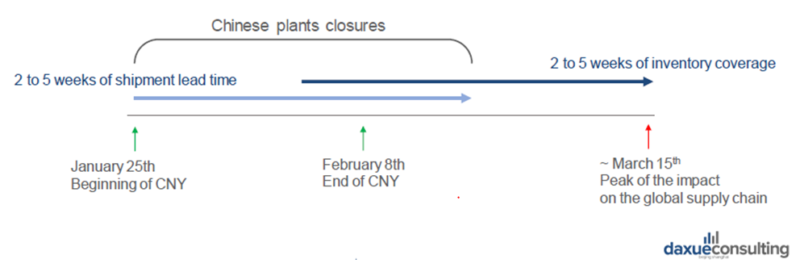
[Source: Harvard Business Review, Coronavirus China Economic Impact report by daxue consulting. COVID-19’s impact on supply chains will last far beyond the end of the epidemic.]
Assessing the coronavirus impact on supply chain in China, the electronics industry seems to be more affected. Intermediate products, which produced in China, are deeply integrated in the global technology supply chain.
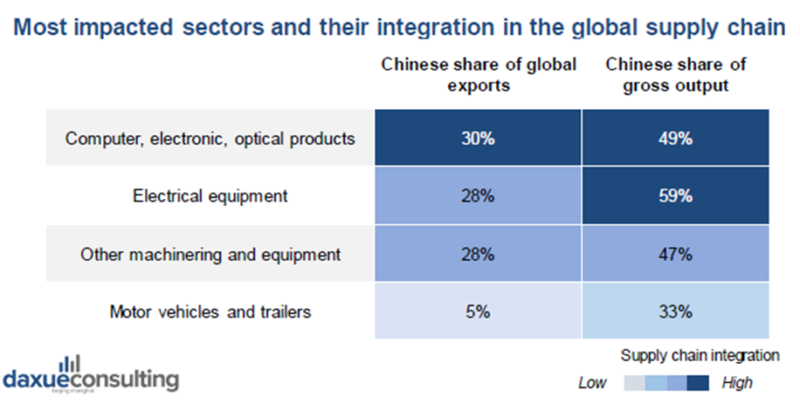
[Data Source: McKinsey, Coronavirus COVID-19, Facts and Insights report]
Operations are concentrated near the affected areas (~290 of about 800 plants named in Apple’s global supplier list are located in regions that have delayed returning to work). Overall, 84% of manufacturers are concerned about delays related to the outbreak. As the components are often heavily customized, it is challenging for factories to relocate outside of China in the short term.
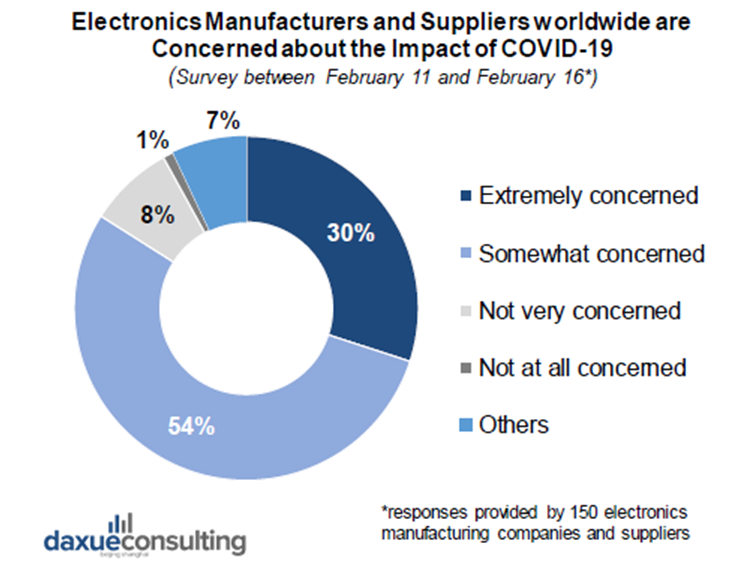
[Data Source: IPC Coronavirus 2020 Report]
COVID-19 economic impact on Chinese manufacturing
As Chinese government shut down Wuhan and delayed the returning to work, many factories have to face the huge losses, limited supply chain and insufficient raw materials. Labor-intensive manufacturers (such as textile, clothing and plastic products) are significantly impacted, small and medium-size factories are worst-hit areas.
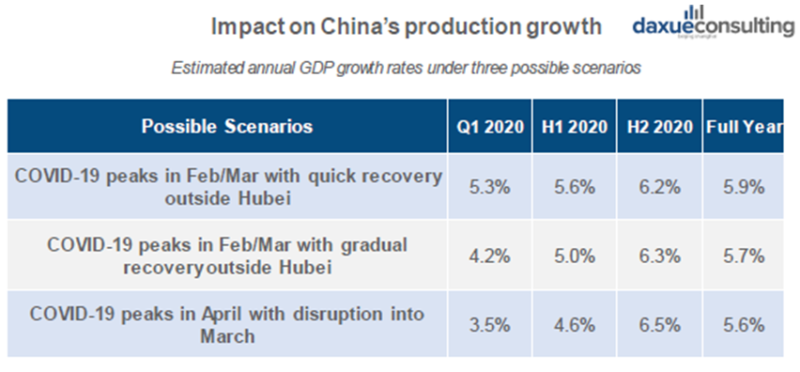
[Source: NBS, Morgan Stanley Research, impact of COVID-19 on manufacturing in China]
According to Morgan Stanley’s report in mid-February, Chinese production had only reached 30% to 50% percent of the usual levels. However, health and medicine related products have a huge demand during the COVID-19 outbreak.
Mask manufacturing demand
After the COVID-19 outbreak, the demand of masks has risen rapidly. Although many companies have started cross-border production, the shortage of raw materials could not be resolved in the short term. China contributes 50% of global mask production. Mask related manufacturers will benefit during the period, however most believe that it is a short-term demand. Expanding production would result in oversupply after the outbreak recession.
China is getting back to work
The week after 9th February is the time for migrant workers to return to work, small and medium-sized enterprises need to resume production to boost cash flow.
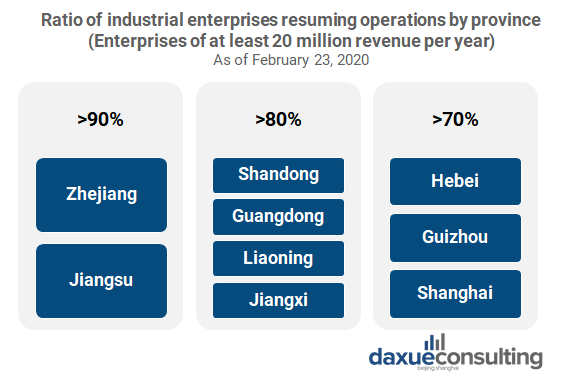
[Source: SinaFinance, Coronavirus China Economic Impact report by daxue consulting. Chinese are returning to work in late February 2020.]
Manufacturing learning points from COVID-19
Although epidemic outbreak is a black swan event in the manufacturing industry, it is likely that COVID-19 China economic impact will be positive. For example, it will promote manufacturing enterprises to strengthen the management of employees’ health and safety. The leaders of manufacturing companies will pay more attention to intelligent manufacturing. Due to online working, manufacturing enterprises will demand software such as task management, project management, and workflow management for remote collaboration. The Coronavirus economic impact in China will also be seen in science industry and smart technologies industry.
Coronavirus economic impact in China: what should exporters to China know
COVID-19 to impact China’s trading partners
After a slowdown in 2016, China’s imports and exports grew despite the trade war. Due to manufacturing and supply chain shortages during the epidemic, this growth rate is expected to slow down. A rebound in export activities may take place in April, while import activities would slow down until July. China’s top trading partners will suffer from the impact of the coronavirus on the main Chinese export products such as computers, broadcasting equipment, integrated circuits, and smartphones.
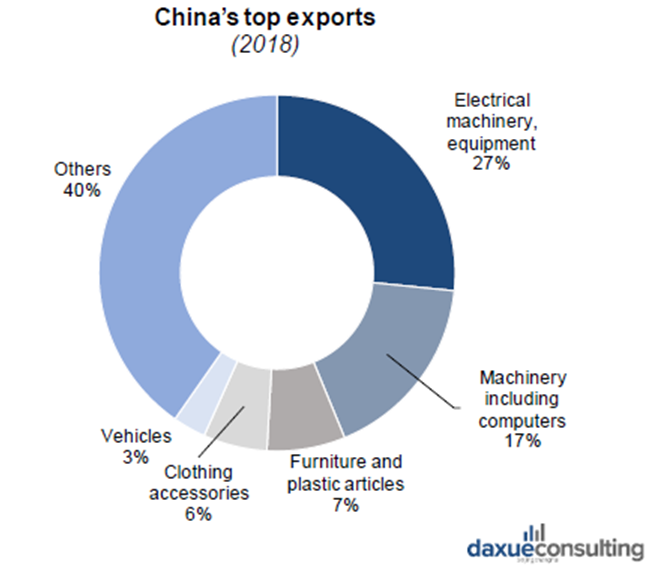
[Source: World top exports, Trading economics]
Coronavirus impact on supply chain in China is expressed in slowing shipments across the country, making transport routes congested. Currently, overall trucking supply resumed operation at around 60% and is a bit higher in the Southern areas of China. Overall intercontinental rail capacity has recovered to 60%.
How to improve supply chain during the epidemic
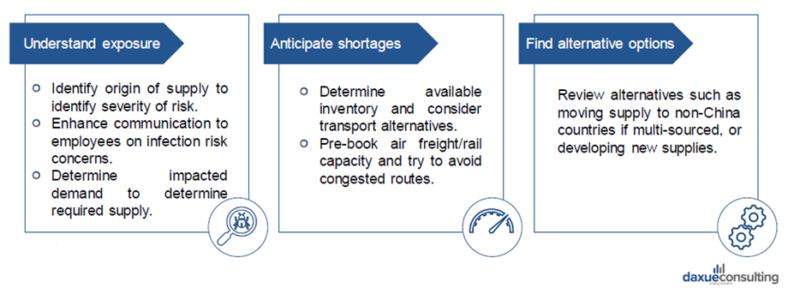
[Source: McKinsey, steps to improve supply chain during the Coronavirus outbreak]
Government response to soften the Coronavirus economic impact in China
Policy support from the Chinese government
Production stop, isolation of staff and transportation restriction were a consequence of coronavirus China economic impact. Policy support and costs reduction are desperately needed. The Chinese local governments released some polices to relieve this situation, such as financial support of small businesses, flexible employment policies, social insurance, rent subsidy and tax concessions.
Long-term economic impact of the Coronavirus in China
The epidemic further boosted digitalization
During the epidemic, both the number of users and the time spent online had a dramatic increase. The total mobile Internet traffic increased by 36.4% compared with 2019 CNY. The number of daily active mobile shoppers grew by 14.6% during the 2020 CNY compared with 2019 CNY. In the meantime, some traditionally offline industries have turned to e-commerce to relieve losses.
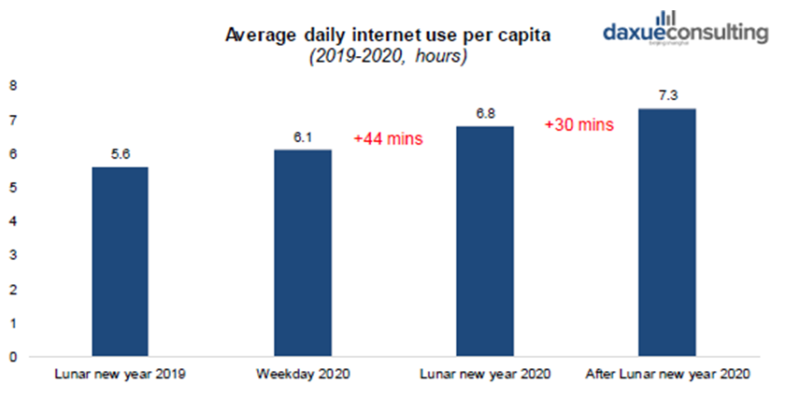
[Data source: Quest Mobile. Coronavirus China Economic Impact report by daxue consulting, average daily internet use rises during the outbreak.]
Coronavirus China economic impact on the luxury market
COVID-19 is a downturn to the global luxury market. In Shanghai, Beijing, Shenzhen, Guangzhou and Wuhan, the passenger flow in large shopping malls and luxury brands stores declined more than 80% during the 2020 CNY. Also, due to the COVID-19, most Chinese consumers are more focus on healthy and rational consumption, many luxury products buyers plan to spend less on luxury goods, more on medical products and necessities. When COVID-19 is under control, this trend may still continue so long as the economy is impacted and until consumer confidence returns.

[Source: McKinsey Global Institute, Barrons, Shanghai Jiao Tong University]
Coronavirus economic impact in China: big data innovation
During the epidemic, more than 20 provinces’ governments worked with technology companies to build “epidemic prevention system”. The reports helped to see related data, epidemic feedback, quickly find and isolate suspected cases. The cooperation between government and big data platforms is promoting the practical application of big data in public crisis management and driving more technology innovation. Along with the development of the epidemic, more Chinese people are getting used to using big data tools in their daily lives, which speed up the process of digital life.
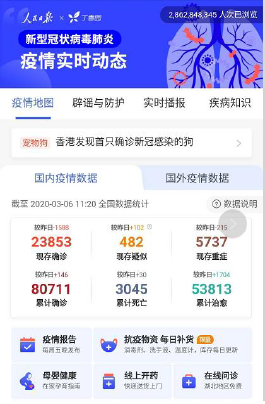
Coronavirus economic impact in China: AI developments
The epidemic promoted the actual use of artificial intelligence products in medical and public safety areas. For example, in order to improve the efficiency of the diagnosis for COVID-19, Beijing Haidian hospital is using an AI assisted diagnosis system that can process 300 chest X-ray in 10 seconds. Many consumers fear the coronavirus cast a shadow over the food delivery industry. Therefore, JD launched autonomous delivery robots to reduce human-to-human contact during the Coronavirus outbreak. Besides, AI medical robots have started to work in Wuhan’s hospitals, they help doctors and nurses with disinfection, cleaning and delivering medicine.


Coronavirus China economic impact: financial assets may surpass fixed assets
Due to the COVID-19 outbreak, most Chinese people have to stay at home, real estate transactions are almost completely frozen. However, financial assets are not limited by places, the bond market has been very active since the Chinese New Year. The Chinese people have more time to invest bank financing products and bonds. Besides, growing savings may increase the demand for investments with stable income, such as bank financing and bond funds.





